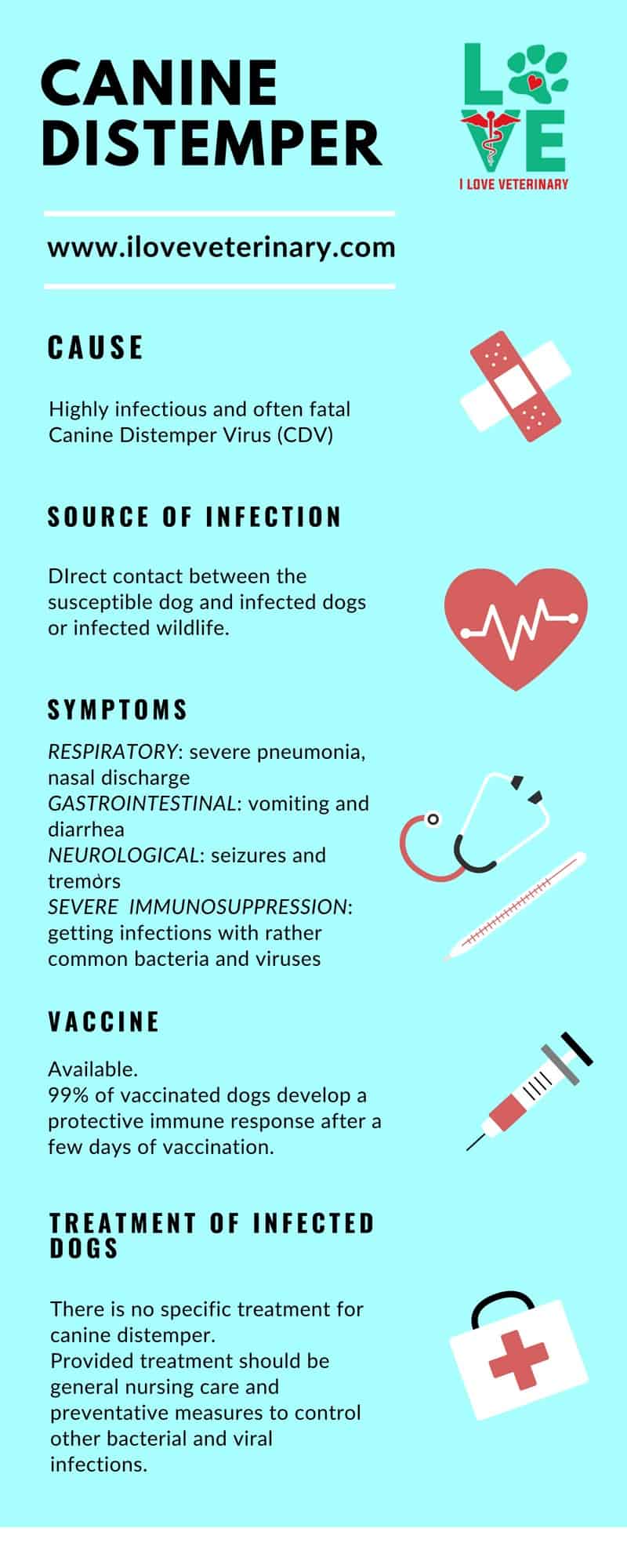What is Canine Distemper Virus?
Canine distemper virus is a devastating disease that affects dogs and especially young puppies. Canine distemper virus (CDV) is a species of the genus “Morbillivirus” belonging to the family “Paramyxoviridae”. It is a zoonotic, highly contagious disease that affects animals in the order Carnivora. The virus has been isolated from jackals, mongooses, and bats.
The canine distemper virus is a negative-strand RNA virus that contains six structural proteins: F (matrix protein), HN (hemagglutinin-neuraminidase protein), G N/C, SH, M, and L.
The viral particles are not enveloped and consist of matrix protein with two types of spikes – hemagglutinin-neuraminidase and fusion glycoprotein that contains receptor binding sites.
Clinical Signs and Symptoms of Distemper in Dogs
In dogs, CDV leads at first to respiratory signs with fever reaching up to 106°F/41°C and nervous manifestations such as fits of aggression or anxious behavior. The epithelium lining of nasal mucosa changes color from clear-pink to dark gray.
In more severe cases the dog exhibits neurological symptoms, including circling movements and seizures. Pneumonia can be observed during later stages of the disease, and death occurs frequently. Morbidity is very high during canine distemper outbreaks; the mortality rate in unvaccinated puppies can be 100%.
The Worldwide Spread of CDV
CDV has a worldwide distribution especially in tropical and subtropical areas (Africa, China, South America). It usually takes the form of canine panleukopenia or canine distemper.
The virus is spread by aerosol droplets or by contact with discharges from infected animals’ eyes, noses, and mouths. At the beginning of the infection, there are respiratory signs connected with paresis of hindlimbs due to paralysis caused by vasculitis.
This leads to the accumulation of blood in vessels that supply limb muscles which then damages them irreversibly. Later on, the canine distemper virus can be detected in canine respiratory and urinary tracts as well as the brain.
On the infographic below you can find quick info about the most important aspects of the disease. Get this as a poster for your clinic or classroom! Order HERE!

The Transmission of Canine Distemper Virus
Since canine distemper virus can be present in canine excretions it is easily transmitted throughout canine populations at the beginning of the epidemic. Dogs that recover from CDV do not show temporary immunity, but if they are not infected with the canine distemper virus for a year or more following recovery, they will develop long-term immunity against canine distemper.
But this immunity can disappear with age. The primary threat to pet dogs is infection by CDV after contact with an infected dog or wild animal. Pregnant bitches should also be vaccinated since canine distemper virus can cause fetal death during pregnancy, especially between the 28th day of gestation and the end of the lactation period.
Other Facts on the Canine Distemper Virus
Canine distemper is one of the most common canine diseases, caused by canine distemper virus, or CDV. It is a very serious disease that can lead to blindness, pneumonia, and even death.
CDV belongs to the Morbillivirus group which also includes measles in humans and rinderpest in cattle. After being exposed, there may be no signs of illness for seven days during which time the virus effectively replicates itself within the host animal’s cells.
Once it has done so, symptoms will appear very quickly and include fever, runny nose/eyes, coughing, vomiting, diarrhea, seizures, ulcers on the tongue and gums as well as sores around the canine’s genitalia.

CDV is highly contagious and it can be contracted by both canine species as well as other members of the family Canidae (wolves, foxes). However, dogs are most commonly infected with the canine distemper virus which is why the canine variant of the disease is more common.
It can also spread to wild populations if they come into contact with domestic dogs who may not even show signs of illness themselves.
Canine distemper virus has a gestation period of 10 days but, once it has displayed itself in an infected canine, death will usually follow within three weeks. If the canine does survive they will remain infectious for up to six months after illness which makes them likely sources of infection during that time although canine distemper immunity can last for several years.
